Vitamin C is a powerful antioxidant that offers a wide range of benefits for your skin. It helps to protect the skin from free radical damage caused by environmental factors such as pollution and UV radiation. This can help to prevent premature aging and reduce the appearance of fine lines and wrinkles. Vitamin C also plays a key role in the production of collagen, a protein that helps to keep the skin firm and youthful-looking. By promoting collagen synthesis, vitamin C can help to improve the overall texture and tone of the skin, leading to a more radiant and healthy complexion.
In addition to its anti-aging properties, vitamin C also has brightening effects on the skin. It can help to fade dark spots and hyperpigmentation, giving the skin a more even and luminous appearance. Vitamin C is also known for its anti-inflammatory properties, which can help to calm redness and irritation in the skin. Overall, incorporating vitamin C into your skincare routine can help to improve the overall health and appearance of your skin, leaving it looking more youthful, radiant, and even-toned.
Summary
- Vitamin C can help brighten and even out skin tone, reduce the appearance of fine lines and wrinkles, and protect against environmental damage.
- Vitamin C serums work by neutralising free radicals, stimulating collagen production, and inhibiting melanin production.
- When making your own vitamin C serum, choose ingredients like L-ascorbic acid, distilled water, and aloe vera gel for best results.
- Follow a step-by-step guide to make your own vitamin C serum at home, ensuring proper measurements and storage.
- Store your DIY vitamin C serum in a dark, airtight container and use it within a few weeks to prevent oxidation and loss of effectiveness.
Understanding the Science Behind Vitamin C Serums
Vitamin C serums are a popular skincare product that harnesses the power of vitamin C to deliver targeted benefits to the skin. The key to the effectiveness of vitamin C serums lies in their formulation. Vitamin C is a notoriously unstable ingredient, meaning that it can easily degrade when exposed to air, light, and heat. To overcome this challenge, vitamin C serums are formulated with stable derivatives of vitamin C, such as ascorbic acid or sodium ascorbyl phosphate, which are more resistant to degradation.
When applied to the skin, vitamin C serums work by penetrating the epidermis and dermis layers, where they can exert their antioxidant and collagen-boosting effects. The antioxidant properties of vitamin C help to neutralize free radicals and protect the skin from oxidative stress, while its role in collagen synthesis helps to improve the firmness and elasticity of the skin. Additionally, vitamin C serums can also help to inhibit the production of melanin, the pigment responsible for dark spots and hyperpigmentation, leading to a brighter and more even complexion.
Choosing the Right Ingredients for Your DIY Vitamin C Serum
If you’re interested in creating your own vitamin C serum at home, it’s important to choose the right ingredients to ensure its effectiveness and stability. The key ingredient in any DIY vitamin C serum is, of course, vitamin C itself. There are several different forms of vitamin C that can be used in skincare formulations, each with its own benefits and considerations. Ascorbic acid is the most potent form of vitamin C, but it is also the most unstable and can cause irritation in some individuals. Sodium ascorbyl phosphate is a more stable and gentle alternative that is suitable for all skin types.
In addition to vitamin C, you’ll also need to choose other ingredients to enhance the stability and efficacy of your DIY serum. For example, you may want to include aloe vera gel or hyaluronic acid to provide hydration and soothe the skin. You could also consider adding vitamin E, another powerful antioxidant that can work synergistically with vitamin C to boost its effectiveness. Finally, you’ll need a suitable base for your serum, such as distilled water or aloe vera juice, as well as a preservative to prevent microbial growth.
Step-by-Step Guide to Making Your Own Vitamin C Serum
Making your own vitamin C serum at home is a relatively simple process that requires just a few key ingredients and some basic equipment. To get started, you’ll need a small glass bottle with a dropper for storing your serum, as well as a small mixing bowl and whisk for combining the ingredients. Begin by measuring out your chosen form of vitamin C – whether it’s ascorbic acid or sodium ascorbyl phosphate – and adding it to the mixing bowl. Next, add your chosen base – such as distilled water or aloe vera juice – and mix well until the vitamin C is fully dissolved.
Once the vitamin C is fully dissolved, you can add any additional ingredients you’d like to include in your serum, such as hyaluronic acid or vitamin E. Mix everything together thoroughly to ensure that all the ingredients are well combined. Finally, transfer your serum into the glass bottle using a funnel if necessary, and store it in a cool, dark place to help preserve its stability. It’s important to note that homemade vitamin C serums may not have the same potency or stability as commercially produced products, so it’s best to make small batches and use them up relatively quickly.
Tips for Storing and Using Your DIY Vitamin C Serum
Once you’ve made your own DIY vitamin C serum, it’s important to store it properly to maintain its effectiveness. Vitamin C is sensitive to light and air, so it’s best to store your serum in a dark glass bottle with a tight-fitting lid to protect it from degradation. Keep your serum in a cool, dark place, such as a cupboard or drawer, rather than on a windowsill or countertop where it could be exposed to light and heat. Additionally, using your serum within a few weeks of making it can help to ensure that it remains potent and effective.
When it comes to using your DIY vitamin C serum, it’s best to apply it to clean, dry skin after cleansing and toning. A few drops of serum should be enough to cover your entire face and neck, and you can gently massage it into the skin using upward strokes. Allow the serum to fully absorb before applying any additional skincare products or makeup. It’s also important to use sunscreen during the day when using vitamin C serums, as they can make the skin more sensitive to UV radiation. By following these tips for storing and using your DIY serum, you can maximise its effectiveness and enjoy its benefits for your skin.
Incorporating Vitamin C Serum into Your Skincare Routine
Incorporating a vitamin C serum into your skincare routine can help to enhance the overall health and appearance of your skin. Vitamin C serums are typically used in the morning as part of your daytime skincare routine, as they can help to protect the skin from environmental damage throughout the day. After cleansing and toning your skin, apply a few drops of vitamin C serum to your face and neck, taking care to avoid the delicate eye area. Allow the serum to fully absorb before applying any moisturiser or sunscreen.
It’s important to note that vitamin C serums can cause some tingling or mild irritation when first used, especially if you have sensitive skin. If you experience any discomfort, you can try diluting the serum with a few drops of water before applying it to your skin. Over time, your skin may become more accustomed to the serum and any initial irritation should subside. With regular use, you should start to see improvements in the overall tone and texture of your skin, as well as a reduction in the appearance of dark spots and fine lines.
Potential Side Effects and Precautions to Consider
While vitamin C serums offer numerous benefits for the skin, there are some potential side effects and precautions to consider when using them. Some individuals may experience mild irritation or tingling when first using a vitamin C serum, particularly if they have sensitive skin. This should subside with continued use, but if you experience persistent redness or discomfort, it’s best to discontinue use and consult a dermatologist.
It’s also important to be mindful of how you store and use your vitamin C serum to maintain its stability and effectiveness. As mentioned earlier, storing your serum in a cool, dark place and using it within a few weeks of making it can help to preserve its potency. Additionally, using sunscreen during the day is essential when using vitamin C serums, as they can make the skin more sensitive to UV radiation.
In conclusion, vitamin C serums are a valuable addition to any skincare routine, offering antioxidant protection, collagen-boosting effects, and brightening benefits for the skin. By understanding the science behind vitamin C serums and choosing the right ingredients for a DIY formulation, you can create an effective serum at home that helps to improve the overall health and appearance of your skin. With proper storage and usage, incorporating a vitamin C serum into your skincare routine can help you achieve a more radiant, youthful complexion while minimising potential side effects.
Discover the Secrets to Glowing Skin with Our DIY Vitamin C Serum Recipe and learn more about the benefits of professional facials in our related article. Professional facials offer a range of benefits, from deep cleansing and exfoliation to promoting skin rejuvenation and relaxation. Find out how incorporating professional facials into your skincare routine can help you achieve radiant, healthy-looking skin. Visit bestskincareproducts.eu to read more about this topic and stay updated on the latest skincare trends and tips.
FAQs
What are the benefits of using a DIY vitamin C serum for glowing skin?
Using a DIY vitamin C serum can help to brighten and even out the skin tone, reduce the appearance of dark spots and hyperpigmentation, stimulate collagen production, and protect the skin from environmental damage.
What ingredients are needed to make a DIY vitamin C serum?
The main ingredients needed to make a DIY vitamin C serum include L-ascorbic acid (vitamin C powder), distilled water, glycerin, and a preservative such as vitamin E oil or grapefruit seed extract.
How do you make a DIY vitamin C serum?
To make a DIY vitamin C serum, you will need to mix L-ascorbic acid powder with distilled water, add glycerin and a preservative, and then store the serum in a dark, airtight container to prevent oxidation.
How should a DIY vitamin C serum be used in a skincare routine?
A DIY vitamin C serum can be used in the morning after cleansing and toning the skin, but before applying moisturizer and sunscreen. It is important to follow up with sunscreen as vitamin C can make the skin more sensitive to UV rays.
Are there any potential risks or side effects of using a DIY vitamin C serum?
Some potential risks of using a DIY vitamin C serum include skin irritation, allergic reactions, and increased sensitivity to sunlight. It is important to do a patch test before using the serum and to start with a lower concentration of vitamin C to minimize the risk of irritation.




